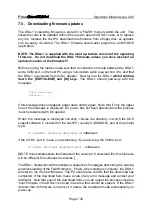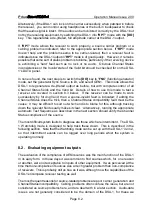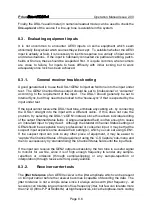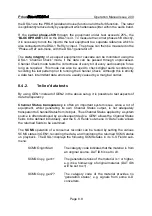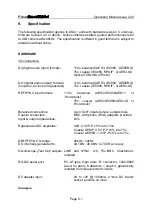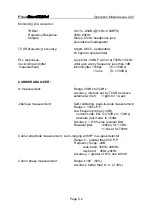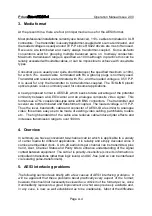
Prism
Operation Manual Issue 2.00
Page 8.11
The Eye Closure measurement is a variation on the same principle. It measures the
narrowing of the eye of the narrow pulse in the X-preamble, rather than in the audio
data areas of the carrier. This is preferable for two reasons: The narrowing of that
particular eye is normally the worst of any eye in the carrier, since it is a 1UI pulse
immediately following a 3UI pulse and the intersymbol interference effect is dominated
by this ratio. Also, since this eye is not in the audio data area of the carrier it is largely
unaffected by the audio data. So the Eye Closure measurement is a worst-case figure
which can be made independent of program content. Like the Data Jitter reading, the
Eye Narrowing reading is also inflated by fs jitter from the source. The 40ns implied
limit from the interface standard is the same as for data jitter.
The data integrity of the AES3 carrier on the interconnect can be checked using the
DSA-1 'Channel Check' mode, which tests the correctness of every bit of every audio
sample for as long as required. This test can be done using the DSA-1 to drive and
receive the interconnect, but this method is not very useful since it tests the ability of
the DSA-1 to transact data over the interconnect rather than that of the actual
equipment normally connected to it. It is therefore preferable to inject and extract the
test pattern through the normal driver and receiver if possible; this is straightforward
where reclocking routing switchers or distribution amplifiers are installed, but may be
less easy if equipment is cabled directly.
For details of evaluating cabling for its effects on sampling jitter in conversion devices,
see the following section.
8.6. Evaluating A/D and D/A converters
This section contains a brief summary of the issues of sampling jitter; these are covered
in depth in the jitter papers listed in appendix D.
Assessment of the performance of A/D and D/A converters is a complex issue, and one
for which the DSA-1 as a carrier generator/analyser is not intended. Audio signal
generator/analysers such as the Prism Sound Dscope system are appropriate to this
task. However, there are carrier-related performance criteria which apply to converters.
The main area is that of sampling jitter, whereby audio distortion is introduced at an A/D
or D/A conversion owing to jitter in the clock of the converter sub-system itself. Since,
in systems, A/D and especially D/A converters rarely generate their conversion clocks
from a local oscillator, but rather from an AES3 or AES11 external reference, there is
considerable scope for interface jitter to cause sampling jitter. However, it should be
remembered that the two are not necessarily directly connected, and proper design of
conversion equipment can effectively prevent the connection. But at present, most
conversion equipment is not properly designed in this respect and for most, any audio-
band jitter applied to the reference input will appear unattenuated at the converter sub-
system.



